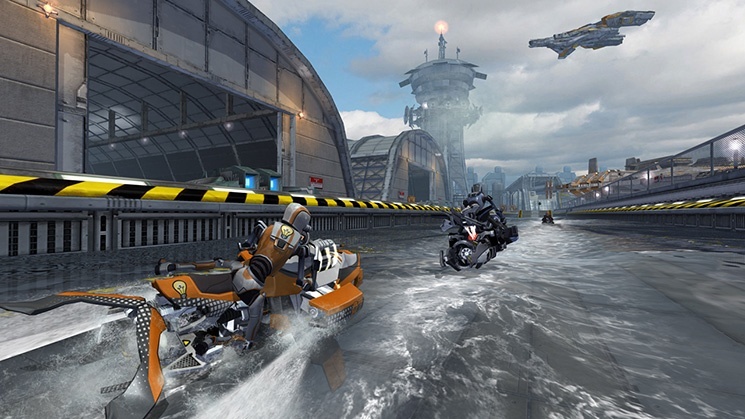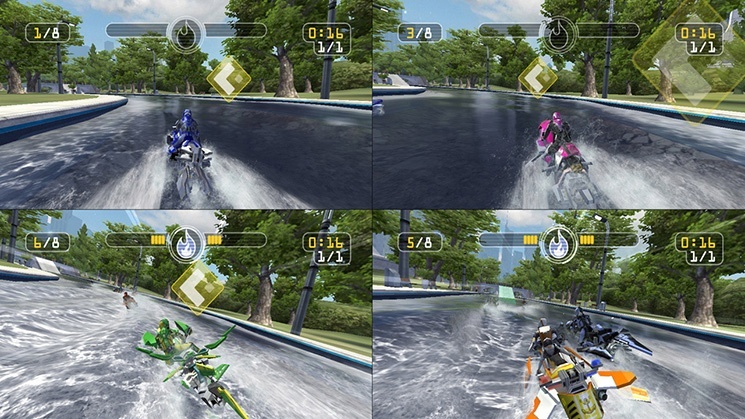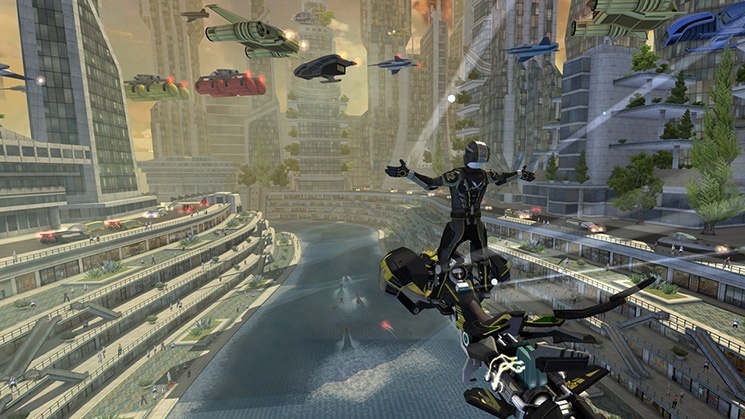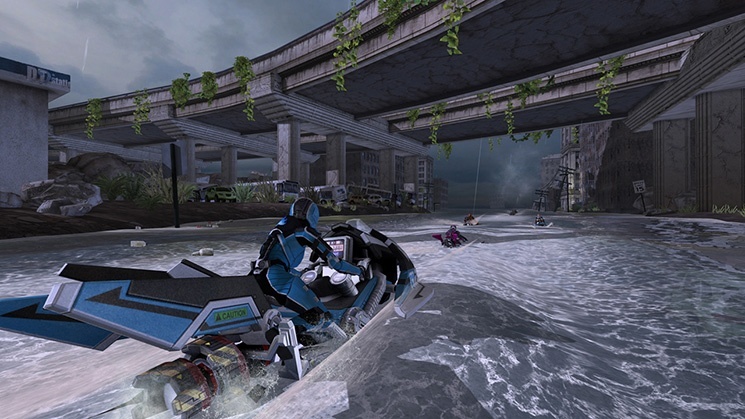Riptide GP: Renegade (Nintendo Switch) Review
By Rudy Lavaux  28.06.2018
28.06.2018

Who remembers Wave Race, the Jet Ski game series made by Nintendo that saw two releases in the late 1990s and early 2000s and then vanished for good? Cubed3 certainly does and although it is not a Wave Race title being reviewed here, the parallels with Nintendo's series, which remains a reference in the genre, are going to be unavoidable, although vehicles in Riptide GP: Renegade are not proper "Stand Up" Jet Skis but rather futuristic looking "Sit Down" personal water craft. Beyond that mild difference, however, there is also the promise of some elements not found in Wave Race. Developer Vector Unit has indeed made a reputation for itself in the water physics racing genre over the years, starting with Hydro Thunder Hurricane for Xbox 360, a game in yet another household series of water-based racing from the 1990s, which did give Wave Race a run for its money back on the Nintendo 64, at least in North America. Its previous games, Riptide GP and Riptide GP 2 combine over half a million installations on Android devices alone and, for quite some time, simply didn't have any competition in the genre. After Riptide GP 2 already came to Xbox One and PS4, the latest release, Riptide GP: Renegade arrived on consoles in 2016 and then on Nintendo Switch late last year.
The title quickly introduces the player to two possible characters to play as in the career mode, which has the player take on successive challenges not so dissimilar to F-Zero GX's own story mode, just as varied perhaps although far more plentiful in this case and once that choice has been made, text-based dialogue will occur at intervals between each event to convey a semblance of plot, although really it is just a pretext for the racing action. The career mode is rather long and packed full of content that should last a long while, along with the possibility and, soon enough, "necessity," of upgrading the player's skills by unlocking more possible stunts, or upgrading the character's crafts as well, improving such things as acceleration, top speed, and so on, and so forth, using the game's currency, earned at the end of each race. If an event feels a bit too harsh to get through to even be able to continue on, it is always possible to go back and grind money a little bit to further enhance skills and specs to ease the difficulty a bit, but it should never feel so unfair that it should become a necessity and simply playing well through each event and keeping investing money in the right perks should ensure that grinding be kept to a strict minimum throughout.
Outside the career mode, which is front and centre in the experience, a more traditional quick race mode is present where players simply select their track, character, and vehicle, and start racing against the CPU. These solo races, without some special objectives found in the career mode, do not offer quite the same thrill beyond the challenge that the CPU-controlled opponents have to offer, but this is arguably also the case playing the likes of Mario Kart in solo. It is really in multiplayer that this truly shines, outside of the career mode, that is. Multiplayer pits anywhere from two to four on-screen players against one another in a GP cup of either the first four tracks, the last four, six out of eight, or even all eight tracks one after the other in four different speed settings, akin to the 50 to 150cc found in Mario Kart.

Interestingly enough, these races being labelled as illegal in the career mode, police crafts will be present in the middle of races, even outside said mode, and can be used to catch their slipstream to help the player catch up with the CPU or human player leading the pack, which is a great way to implement a sort of rubber banding in multiplayer in the absence of items à la Mario Kart. Last, but not least, the indispensable online mode is present but could sadly not be tested on Switch due to a simple lack of other players found to play with at time of writing. Adding to all this, the amount of tracks to race on is pretty decent with eight available. Each is packed with delicious detail of the in-game world, like traffic on the roads visible on each side or that sort of thing. There is some love poured into the making of this and it shows, which from a developer for whom Microsoft Games Studio acquired the Hydro Thunder licence from Warner Bros. in the past, should not be all too surprising.
Being on consoles means that a game that was originally built for devices without physical controls had to be translated to physical controls in the process, which raises the immediate question of whether or not the controls are any good. The answer to that is simply that they are perfectly good! Default controls map movement to the control stick, as expected, while using both controls sticks at the same time during jump, tilting them in combinations of directions, performs tricks and stunts that are much more easily pulled off than those of Wave Race. This is not so much about stunts as much as it was in Nintendo's franchise, but rather stunts had to be easy to be performed because of their role in this particular title. Stunts fill up the boost gauge and while they are perhaps easy to pull off, what is not so easy is to decide when and where to do so. Indeed, depending on the track, ramps that would allow the player to perform those tricks in the air may not always be widespread and waves themselves can't be relied on as much as in Wave Race to pull tricks off of. In that sense, it is indeed closer in gameplay style to Hydro Thunder than it is to Wave Race, although Hydro Thunder had power-ups and Riptide does not, so its sits somewhere in the middle between both styles.

Another question players may have is whether or not the Switch version retains the smart device controls since, after all, the Switch, once the Joy-Con are detached, is but a glorified tablet with the same gyro and touchscreen capacity. The answer to this question is no, it doesn't. In that regard, the Switch version is rather a faithful carbon copy of what is on offer on other home consoles, but with a twist: single Joy-Con controls. Both sticks being utilised to perform stunts, one could think that, therefore, single Joy-Con controls would simply not work. Well, believe it or not, they do! Held on its side, a single Joy-Con allows movement control via the single joystick while holding down the top face button and using the joystick in conjunction performs tricks. It's unclear if each trick then corresponds to a different separate and unexplained input, making trying to pull off one trick in particular seemingly impossible, but simply holding the button down and waggling the joystick while in mid-air does seem to make pulling of the trickiest stunts a cinch, so no complaints there. In single Joy-Con mode, the crafts accelerate on their own, which is not altogether surprising since it is a method often used in mobile games, and in this case, considering braking is never really recommended to begin with, so it is in no way a handicap. The only concern is the same as with all other games, which is the smaller size of the sticks on the Joy-Con and something every Switch owner has to come to terms with at some point after purchasing the hybrid system, and certainly not a fault of the software itself.
The Switch version is also a rather faithful copy of other home console version in another regard: multiplayer. While the Switch is a portable console, one could wonder whether or not wireless LAN is an option so that multiple people could play on the go, each on their own screen, or even each on their own TV screen with each console communicating either over local Wi-Fi or over LAN adapters, as is seen with games like Splatoon 2 or even Resident Evil Revelations. Sadly, no. Multiplayer is only handled in split-screen, or over an Internet connection with players around the world. Therefore, if multiple people want to race in local, either in handheld or docked mode but each on their own console for more screen real estate than what split-screen offers, a reliable Internet connection must be available. Nevertheless, split-screen mode is no slouch, especially on a pure technical level.

Granted, Riptide GP: Renegade is still a mobile game in its execution and, therefore, does not rely on the most advanced visual effects for its graphics, but it is still a rather pretty game to look at, even without the most advanced shaders and polygon models. On Nintendo Switch, the game runs at 1080p with a locked 60fps at all times when docked and, yes, that means also in split-screen mode, even with four players on-screen. Given that this is not Mario Kart 8 Deluxe in terms of presentation, this is not entirely too surprising, but still, a commendable effort indeed since this relies quite a bit more on the sensation of speed than Nintendo's own party racer. There is only one performance saving measure clearly visible: less buildings or overall background elements on the side of the tracks in four-player split-screen, which in and of itself is not too big a problem when each player's view of the track is so reduced anyway. In handheld mode, the performance seems to be exactly the same even in four-player split-screen, but seemingly simply scaled back to 720p, as expected. Admittedly, things really do get cramped and small when four people have to gather around such a small screen, but the same goes with all split-screen games in handheld mode on Switch. In two-player split-screen mode on the go, though, with split Joy-Con, without the need to carry around an extra controller, it does work remarkably well and it is not altogether impossible to imagine passing a Joy-Con to your neighbour on the train who may want in on the fun.
While the visuals may not be the most advanced, although artistically still tremendously pleasant and impressive, this brings the one final advantage that the file size of this game is really small. This, on both fronts, is a natural heritage of being a mobile game at core and a mobile conscious way of making the original version for mobile platforms as accessible as possible for people who do flock to these devices that have limited storage to begin with, a trait that Nintendo Switch shares with these since it relies on the same type of technology, so, all in all, the player arguably wins.

Cubed3 Rating
Great - Silver Award

Riptide GP: Renegade on Switch turns to be a faithful port of other home console versions of the same game, complete with the same qualities but also a slightly regrettable lack of two features that could have been possible: gyro/touchscreen controls, as well as support for local wireless or LAN multiplayer. It does add, however, an excellent implementation of single Joy-Con support, ensuring wonderful two-player sessions on the go in split-screen or simply allowing a player with few available controllers to invite friends to participate in the fun when playing in the comfort of their home. It runs and plays remarkably in all modes and retains its great gameplay mechanics and innovations from other versions and is, at time of writing and in the current absence of Wave Race on the Switch, one of the best racing games on the machine that exceeds what one could expect from a game at that price.

![]() 8/10
8/10
![]() 0
(0 Votes)
0
(0 Votes)
 Out now
Out now  Out now
Out now  Out now
Out now  Out now
Out now Comments
Comments are currently disabled

 Sign In
Sign In Game Details
Game Details Subscribe to this topic
Subscribe to this topic Features
Features





 Top
Top

